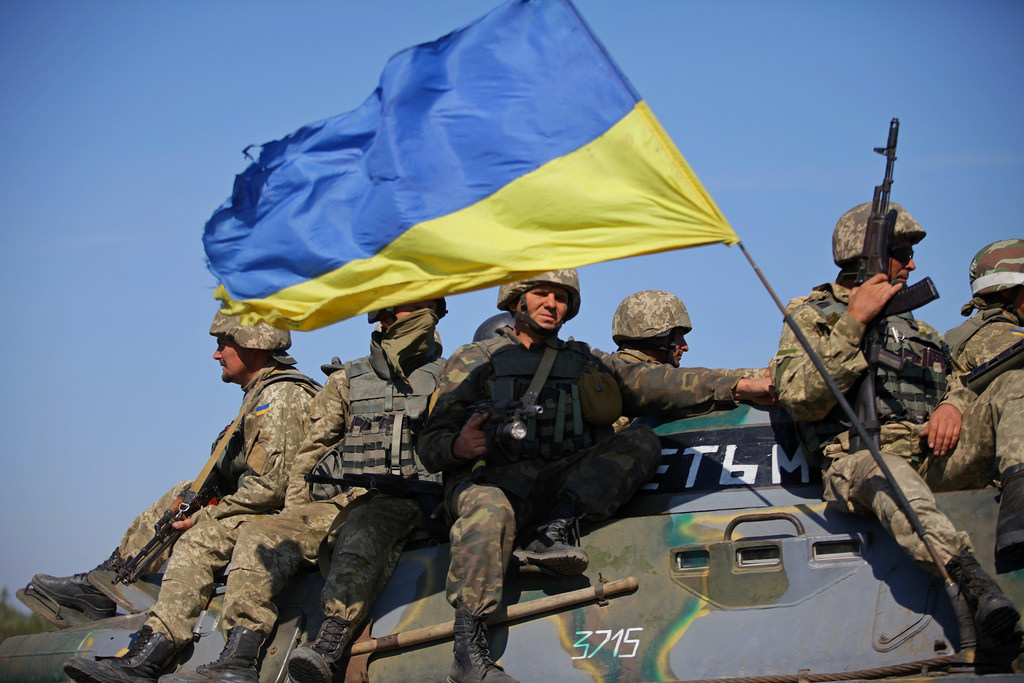Here’s Why A No-Fly Zone Over Ukraine Won’t Work
This week, Ukrainian President Volodymyr Zelenskyy once again pressed US lawmakers to impose a no-fly zone over Ukraine, intended to limit the Russian military’s ability to continue their invasion of his nation. This is far from the first time a no-fly zone has been proposed, but despite the tragic circumstances the Ukrainian people now find themselves in, fighting a superior force for the fate of their nation, Western leaders from the United States and the majority of NATO have been unanimous in dismissing the idea as untenable.
A no-fly zone is simply the prohibition of all or certain aircraft from operating within a defined airspace, and while that might seem like a great idea in theory, its the execution that makes it tricky.
Related: What can Americans do to help Ukraine?
How to assess the value of a no-fly zone over Ukraine
In order to realistically determine if a no-fly zone over Ukraine is a good option, you have to be able to look at the situation through an objective lens—and that’s no easy feat while innocent people are being killed by Russian air and missile strikes each day. Establishing a no-fly zone alone does nothing, however. It can only change matters over Ukraine if enforced, and that very likely means combat.
This isn’t just a challenge for those of us working to develop our own positions on the topic in a complex media environment—it’s also a big challenge for policymakers and diplomats tasked with simultaneously maintaining global stability and supporting Ukraine during the largest conflict on European soil since the end of World War II.
Fortunately, the arithmetic isn’t complicated. Assessing the value of a no-fly zone really comes down to a simple risk versus reward proposition. We have to weigh the risks of sending NATO aircraft into Ukrainian airspace to engage Russian helicopters and jets against the potential benefits doing so could provide the Ukrainian people. If, after the math is complete, the risk side of the equation is bigger than the reward side, the concept isn’t a good one.
It’s essential to not fall victim to the “either/or” fallacy, often referred to as the “false dilemma” when doing these sorts of thought exercises. The options aren’t a no-fly zone over Ukraine or nothing. They’re rather, a no-fly zone over Ukraine or a whole slew of other options, some of which may even be more effective.
Related: Commentary: If you want to help Ukraine, keep paying attention
The nuclear elephant in the room

“To anyone who would consider interfering from the outside – if you do, you will face consequences greater than any you have faced in history.”
Russian President Vladimir Putin on February 24, 2022
Arguing against a no-fly zone in Ukraine may seem insensitive or even self-serving, and to some extent, it may really be. But self-serving pragmatism has, for the past 73 years, been the very basis of modern global stability. The advent of nuclear weapons, and more importantly, the Soviet Union’s development of comparable atomic bombs in 1949, forced a dramatic shift in the way global powers engage in direct competition for good reason. Mutually Assured Destruction, or MAD, is predicated on the willingness of nuclear powers to leverage their weapons to lay waste to their opponents, as well as their opponent’s willingness to respond in kind.
And in many ways, this looming threat of total annihilation has been one of—if not the—most effective means of deterring global war in this modern era, ranked just above an increasingly intertwined global economy and well ahead of still-valuable global peace-keeping initiatives like the United Nations.
Ukraine is a large geographical region, slightly smaller than the state of Texas. Policing airspace that large would require a huge number of aircraft and countless opportunities for individual engagements if Russia chose to press into Ukrainian airspace anyway. If this were the case, we’re now talking about American fighters squaring off against Russian pilots in combat—while not unheard of, every exchange would bring our nations significantly closer to open war and potentially even a nuclear one.

But here in the United States, where our modern concept of war is largely based on the Global War on Terror, nuclear annihilation is no longer a pressing anxiety, and as such, many have come to dismiss Putin’s nuclear threats as nothing more than theater. After all, the embattled Russian president knows that launching a nuclear attack on the West would undoubtedly result in Russia’s ruin.
But the argument that America should call Putin’s nuclear bluff is based entirely on the good intentions of a ruthless dictator who feels increasingly backed into a corner economically, militarily, and diplomatically. While it seems unlikely that Putin would resort to nuclear strikes, pressing him to do so would literally mean betting our children’s survival on Putin’s calm, rational decision-making prowess.
This isn’t to say that nuclear war would be an inevitable outcome of establishing a no-fly zone over Ukraine. Rather, it’s highlighting the biggest risk right off the bat. The potential nuclear annihilation of human civilization may sound like hyperbole, but this is one case where our sensationalized concept of nuclear war is, despite pop-culture fictions, accurate enough to give us a real sense of the stakes.
Related: What exactly is America’s nuclear triad?
Previous no-fly zones haven’t worked out as well as you think

As outlined in an excellent piece by Richard K. Betts for Foreign Affairs, our modern concept of no-fly zones is based entirely on sets of circumstances that were nothing like those currently faced over Ukraine.
NATO-enforced no-fly zones (NFZs) were a fairly common facet of warfare during the 1990s and 2000s, seeing use in the early ’90s over Iraq, in the mid-’90s over Bosnia, and in 2011 and later over Libya. As Betts points out, these were nations with limited airpower capabilities that could do very little to stand up to NATO’s massive airpower apparatus. Despite that, in every instance of NATO or U.S. enforced no-fly zones, enforcing them involved kinetic exchanges, or shooting at each other.
In another excellent piece of analysis from retired Navy aviator, attorney, and Associate Professor of Law at Syracuse University Mark Nevitt, published by Just Security, he outlines the circumstances and outcomes of previous efforts to establish and enforce no-fly zones dating back to 1991 (the same listed above). Despite having overwhelming air superiority, NATO aircraft still faced engagement from surface-to-air missiles and even other aircraft, and the complexity of operating massive no-fly zone operations increases other risks, like the potential for friendly fire incidents.
- Iraq: Operation Southern Watch & Northern Watch (1991-2003)
- No-fly zones enacted after the defeat of Iraqi forces
- 2 U.S. Army Blackhawks were shot down in 1994 by friendly fire after being mis-identified
- NATO aircraft were repeatedly fired upon from the ground and “force was employed repeatedly” to maintain the integrity of the NFZ
- Bosnia-Herzegovina (1992,1995)
- U.S. Air Force F-16s were forced to engage and shoot down four Serbian fixed-wing tactical aircraft that were engaging ground forces
- Libya (2011)
Unlike the limited air capabilities offered by these nations, Russia has the second-largest Air Force in the world (though it’s important to note, they are a far second). Trying to enforce a no-fly zone over an area the size of Ukraine against such a large force is something that’s literally never been done, and if contested, could result in the rapid escalation of this conflict.
“There are no examples of something called a ‘no-fly zone’ being imposed on a major power outside the context of battles for air superiority in regular warfare,” Betts explains.
Related: War in Ukraine: The West balances the head and the heart
A no-fly zone over Ukraine would require airstikes inside Russia and potentially even Belarus

Even those taking a pragmatic view of trying to establish and enforce a no-fly zone over Ukraine tend to limit their imagined operation to NATO fighters patrolling airspace to deter or shoot down Russian sorties. That’s part of it, but there’s much more to controlling the airspace of a nation the size of Ukraine than simply pouring fighters into the sky.
Russian air defense systems are widely believed to be among the best in the world, despite their limited success in controlling Ukraine’s airspace to date. Russia’s S-400 Triumf, for example, is often touted as potentially capable of identifying and targeting stealth aircraft, though just how successful it would be against incredibly difficult-to-target platforms like the F-35 remains the subject of a great deal of debate.
However, even if NATO limited its use of fighters within Ukraine to stealth platforms (which wouldn’t be feasible considering the amount of territory to cover and the number of available F-35 and F-22 airframes), NATO’s air presence would not be limited to fighters. Air operations over Ukraine would require massive amounts of fuel flowing into and out of Ukrainian airspace via tankers. Aircraft like the KC-135 Stratotanker would be easy targets for systems like the S-400.

Other essential support aircraft like the E-3 Sentry airborne warning and control system (AWACS) would likewise be easy prey for advanced Russian air defenses. In order to mitigate the threat posed to these aircraft as well as fourth-generation fighters, Russian ground-based air defenses both inside Ukraine and beyond would have to be eliminated at the onset of establishing a no-fly zone. That would require airstrikes against Russian troops and equipment in Ukraine, Russia, and potentially even Belarus if they permitted Russian equipment to operate from their soil, which is fairly likely.
In other words, there is very little chance a no-fly zone could be safely enacted without NATO firing on Russian targets first.
The aforementioned S-400 Triumpf has an operational range of right around 250 miles, which means Russian systems could engage NATO aircraft from well inside Russian territory. These systems would have to be engaged directly, likely using anti-radiation missiles like the AGM-88 HARM that cannot currently be deployed by stealthy jets like the F-35, and would instead have to be carried into Russia aboard modified F-16s or F/A-18 Super Hornets. There are, of course, other methods of targeting air defense systems that don’t rely on radar-hunting missiles, like deploying special operations troops into Russia to identify and target these systems for subsequent airstrikes, but needless to say, sending Delta or Green Berets into Russia would be a significant escalation toward open war.
As we’ve seen in previous situations where no-fly zones were enacted, low-flying NATO aircraft over Ukraine would still face being targetted by systems like Russia’s man-portable 9K38 Igla surface-to-air missiles. That means NATO pilots would be faced with having to decide whether or not to engage Russian ground forces often, dramatically increasing the chances of open conflict once more.
But even if Russia backed down and removed its air defense systems from Ukraine and nearby territory, this war would rage on.
Related: America’s loitering radar-hunting missile is due for a comeback
Even if everything went right, a no-fly zone would have a limited effect

A no-fly zone, if enacted and enforced, would prevent Russian aircraft from operating freely over Ukraine, but that wouldn’t mean an end to attacks from the air or a significant enough reduction in Russia’s military capabilities to give Ukraine a sizeable advantage.
Thus far in the conflict, Russian airpower has failed to dominate Ukrainian airspace and many experts contend airstrikes have consistently been less effective than Russian artillery, rocket barrages and mortar fire. A no-fly zone would do nothing to limit the use of or effectiveness of these weapons. It’s important to remember that even with a sky full of NATO aircraft, Russia would still have some 180,000 troops operating within Ukraine.
Russia’s inability to dominate Ukrainian airspace has allowed Ukraine’s forces to leverage drones for reconnaissance and airstrikes. When enforcing a no-fly zone in Ukraine, NATO would have to decide whether or not it would permit Ukraine to continue to operate aircraft freely, and if so, that too would appear less like enforcing a no-fly zone and more like simply joining the conflict and waging war against Russia.

The limited benefit of a well-enforced no-fly zone took yet another blow this past weekend as Russian heavy-payload strategic bombers launched cruise missiles at targets inside Ukraine from deep within Russian airspace. Weapons like Russia’s air-launched Kh-555 cruise missile have ranges in excess of 2,000 miles. So for NATO to prevent these attacks they would have to either send fighters deep into Russian territory to shoot these bombers down, or deploy crewed air-defense systems inside Ukraine that are capable of intercepting cruise missiles. That would mean putting U.S. troops on the ground inside Ukraine, which again, is a big step toward open war.
And while Russia’s supply of these particularly long-range weapons may be limited, Russia has many weapons with sufficient reach to be fired from inside Russian airspace and still engage Ukrainian targets. In fact, according to the Pentagon, Russian aircraft are flying nearly 200 sorties a day to launch munitions, but most never actually leave Russian airspace.
Related: Russia’s focus on perception is costing them the skies over Ukraine
Ukraine needs help, but a no-fly zone isn’t it

Ukraine faces what could be considered overwhelming odds in its fight for freedom, but thus far, the Ukrainian forces have mounted an astonishing defense. In a very real way, Russia’s strained supply lines, dire economic circumstances, lack of international or domestic support, and Ukraine’s own rugged terrain may all be conspiring toward forcing Vladimir Putin to the negotiating table.
In fact, on Wednesday, Putin may have signaled a willingness to pursue a means to withdraw from Ukraine while still declaring victory domestically. He said Russia would be willing to discuss Ukraine adopting a “neutral status” that would alleviate his claimed concerns about Russian border security. This is a long way off from peace, but it may be the first step toward a negotiated end to hostilities.
But even if it isn’t, many defense experts like retired Marine Corps colonel Andrew Milburn have highlighted the West’s ability to help Ukraine win this fight without ratcheting up the likelihood of global thermonuclear war. In a great piece for Task & Purpose, Milburn lays out how to enable Ukraine’s victory without firing a shot in anger, and to be honest, it looks a lot like what NATO nations are working toward doing.
The plan calls for enabling, supplying, and training Ukrainian forces even if the nation were to fall to Russian invaders, which is clear involvement in the conflict, but is decidedly non-kinetic. Let me clear, that’s a troubling strategy, as it allows for the possibility of a Russian victory and prolonged insurgency—but as we stated at the onset of this now rather long-winded exploration of the concept of a no-fly zone over Ukraine, the arithmetic remains simple.
The potential for expanding this conflict beyond the confines of Ukraine, for escalating this war into something that could engulf a much larger swath of the European continent or even result in nuclear war is just too high to risk sending hundreds of NATO aircraft into this fight, especially with the understanding that all this risk would not lead to an end to this conflict.
A no-fly zone over Ukraine may prevent a relatively small number of airstrikes from taking place inside Ukraine’s airspace, but that’s simply not enough to justify rolling the dice when one potential outcome is the end of all life as we know it.
Ukraine is relying on foreign support in this fight and let there be no doubt, the international community should be, and appears to be, providing it. But a no-fly zone over Ukraine is simply too big a risk with too little potential reward.
Read more from Sandboxx News
" Conservative News Daily does not always share or support the views and opinions expressed here; they are just those of the writer."





